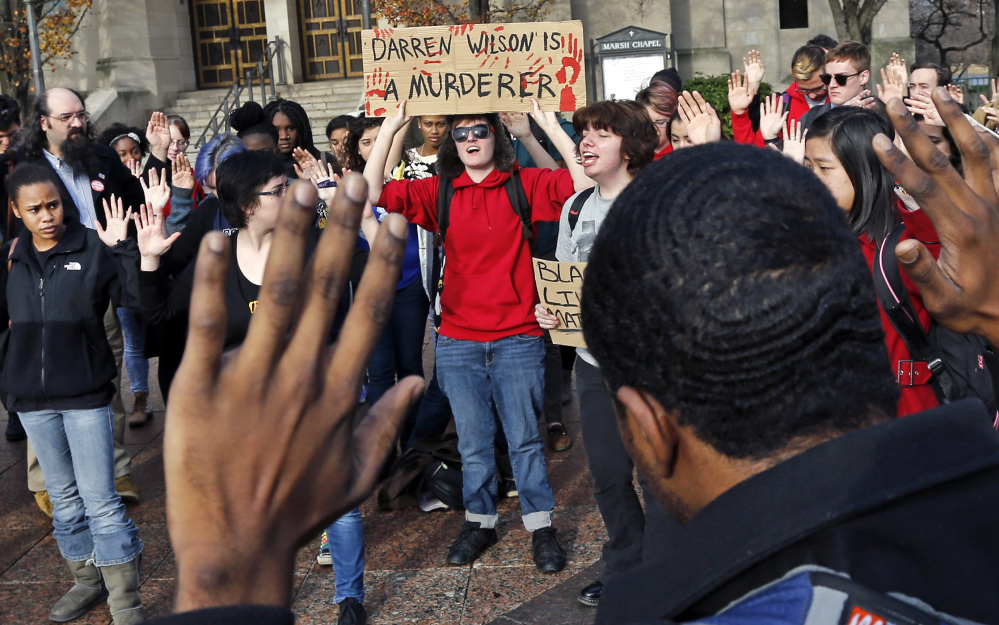ST. LOUIS — Five St. Louis Rams players entered the football field with their hands raised. A day later, people walked out of work or school showing the same gesture of solidarity with Ferguson protesters.
The pose has come to symbolize a movement, even though witnesses offered conflicting accounts of whether 18-year-old Michael Brown had his hands up in surrender when he was killed by Ferguson officer Darren Wilson in August.
The power of the symbol was evident again Monday. Protesters across the country walked off the job or away from class in support of the Ferguson protesters. Walkouts took place in New York, Chicago, San Francisco and elsewhere.
At the University of Missouri-St. Louis, not far from Ferguson, sophomore Amber Whitaker was among about 30 students who chanted “Hands up. Don’t shoot!”
Whitaker, who is white, said the symbolism is what matters, not whether Brown literally had his hands in the air.
“There are black men and women who are shot with their hands up,” Whitaker said. “There are black men and women who are shot unarmed. It may not apply exactly to Mike Brown, but it still happens.”
The exact circumstances surrounding Brown’s death will forever be in dispute. Wilson, who is white, shot and killed Brown, who was black and unarmed, on Aug. 9. A grand jury’s decision last week not to indict Wilson set off renewed protests, some of which turned violent.
Wilson told the grand jury that he shot Brown in self-defense. But several witnesses said Brown had his hands up in surrender. Within hours, “Hands Up. Don’t Shoot!” became the rallying cry for protesters.
Witness accounts contained in thousands of pages of grand jury documents reviewed by The Associated Press showed many variations about whether Brown’s hands were actually raised – and if so, how high.
Some people are offended by the hands-up gesture.
The St. Louis Police Officers Association said the display by Rams players Tavon Austin, Kenny Britt, Stedman Bailey, Jared Cook and Chris Givens was “tasteless, offensive and inflammatory.”
In Springfield, Missouri, Rodney Shetler, watched the players’ action from his home. He said the move was “in pretty poor taste” and was divisive and disrespectful to law enforcement.
“It’s a gesture proven by the grand jury not to be appropriate or accurate,” said Shetler, the 44-year-old owner of a copying and printing business.
A similar episode unfolded more than four decades ago at the 1968 Olympics in Mexico City.
John Carlos, the American 200-meter bronze medalist, set off a political firestorm on the medal stand when he and teammate Tommie Smith gave the black power salute. He stood by the Rams players.
“If they choose to come out and raise their hands in support of whatever their emotions are, they have the right to do that,” Carlos told The Associated Press.
Send questions/comments to the editors.



Success. Please wait for the page to reload. If the page does not reload within 5 seconds, please refresh the page.
Enter your email and password to access comments.
Hi, to comment on stories you must . This profile is in addition to your subscription and website login.
Already have a commenting profile? .
Invalid username/password.
Please check your email to confirm and complete your registration.
Only subscribers are eligible to post comments. Please subscribe or login first for digital access. Here’s why.
Use the form below to reset your password. When you've submitted your account email, we will send an email with a reset code.